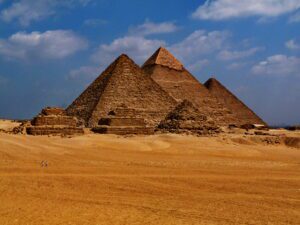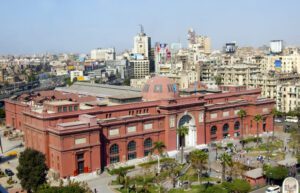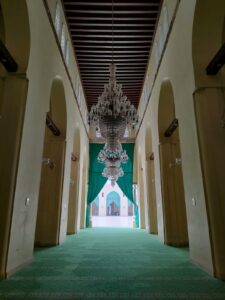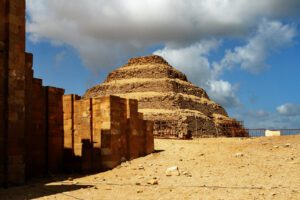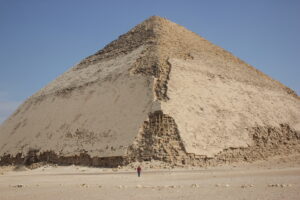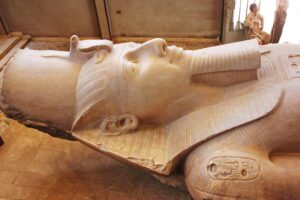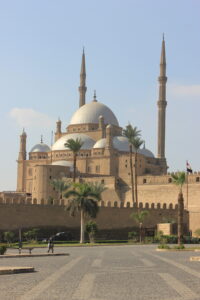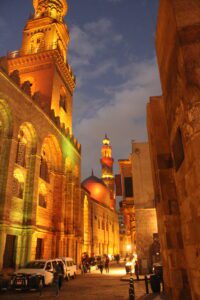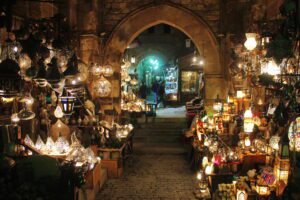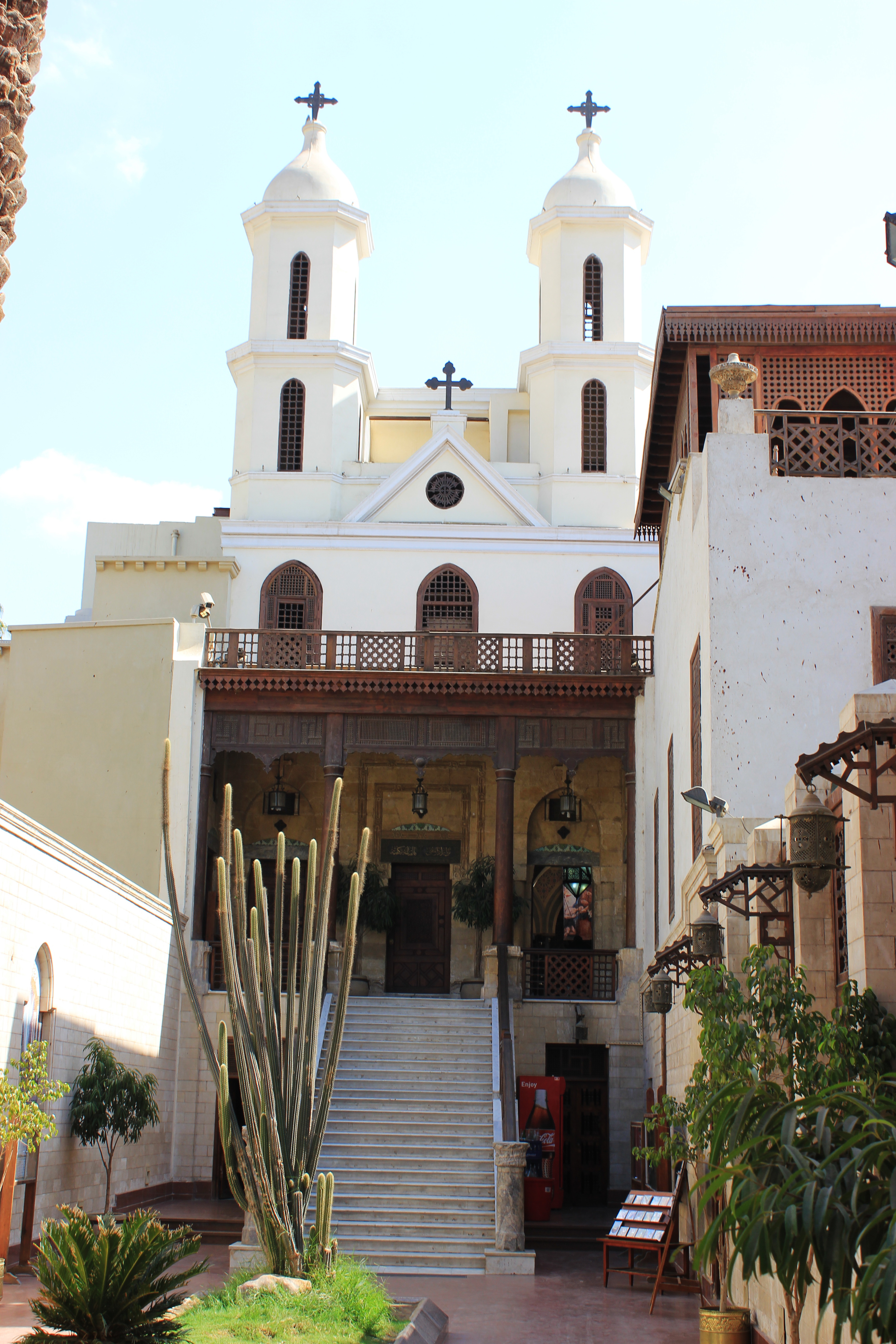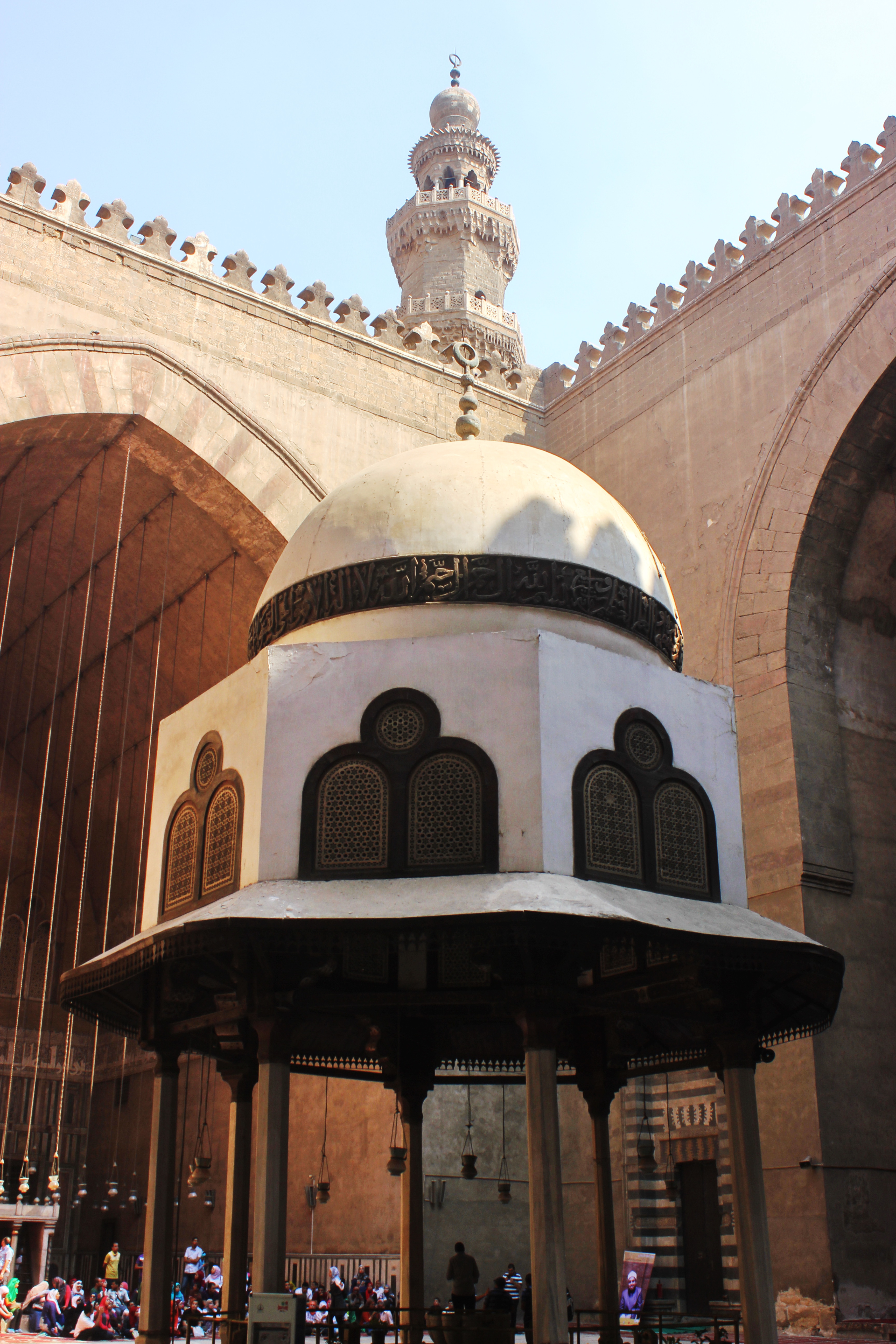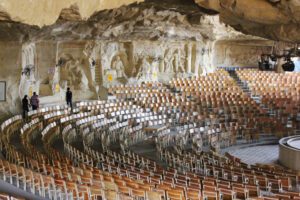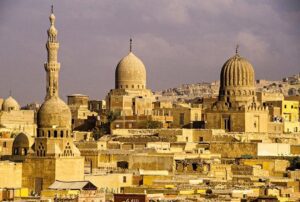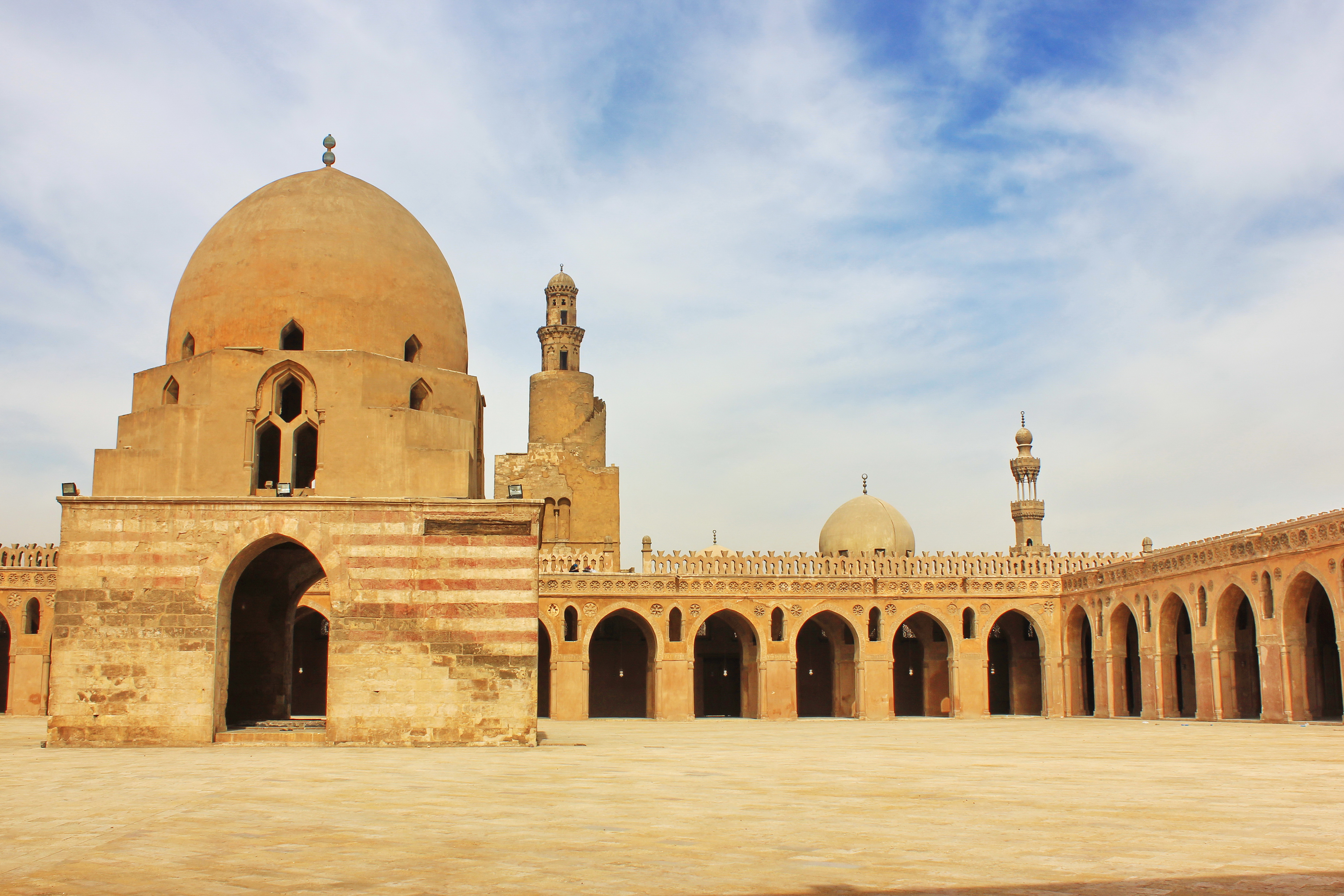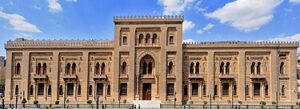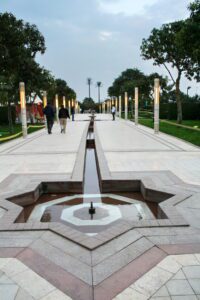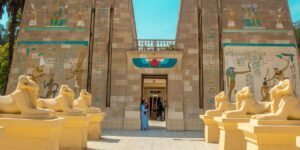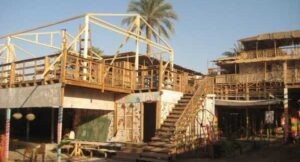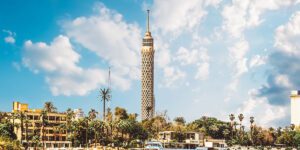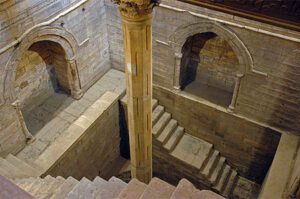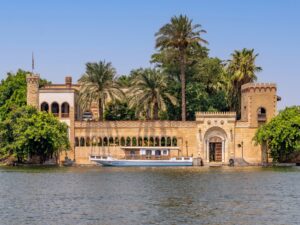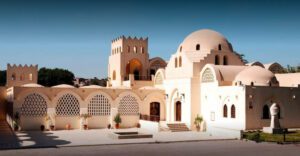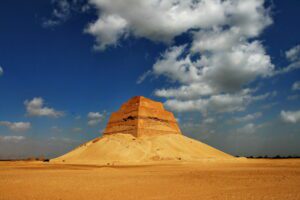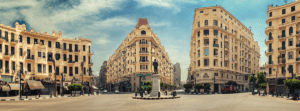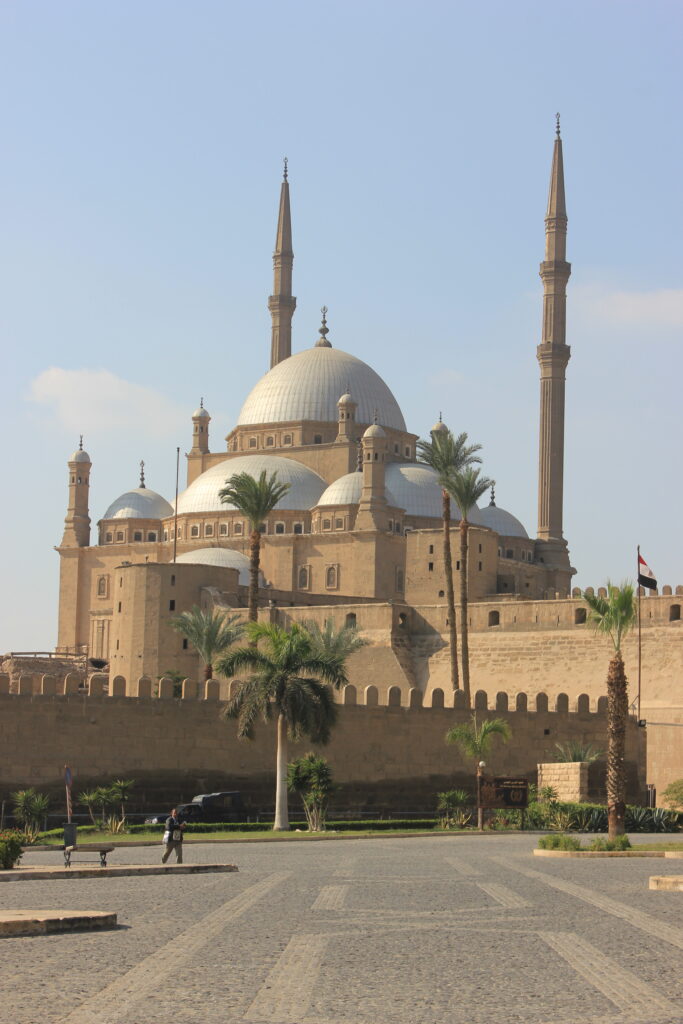
Cairo and Around
Cairo was once acknowledged by Medieval Arab historians as “The Mother of the World”. Today Cairo is a city where ancient, medieval, and modern architecture are intertwined.
The Pyramids, The Sphinx, The Egyptian Museum, Early Christian churches, and Medieval Mosques. Alongside Old Markets, Alleys, Medieval Houses, Modern Five Star Hotels, Shopping Malls, Restaurants, Cinemas, and Theatres.
Cairo and Around
- Giza pyramids and SphinxThe pyramids of Giza, the only survivors of the Seven Wonders of the Ancient World, continue to awe visitors more than 4,000 years after their construction.The Great Pyramid of Khufu (2609–2584 BC) is the largest pyramid in Egypt and the world, and the oldest pyramid in Giza, at 138 meters (453 feet) high. The pyramid of Khufu’s son Khafre (2576–2551 BC) is 136 meters (446 feet) high, and the pyramid of Kafre’s son Menkaure (2551–2523 BC) is 62 meters (203 feet) high. Nearby are three smaller pyramids about 20 meters (66 feet) high, the Pyramids of the Queens. The interiors of the pyramids are not decorated but are noteworthy for the advanced engineering involved in their construction. The Tombs of the Nobles feature detailed scenes reflecting the lives of the ancient rulers. These tombs are of members of the royal family and some important officials. Only a few tombs are open to the public. We approach the Sphinx through the Valley Temple. The Sphinx was carved from one piece of limestone and is 60 meters (197 feet) long and 20 meters (66 feet) wide. ADDITIONAL ACTIVITIES, on request: Going inside the Great Pyramid Entering the Great Pyramid is a memorable experience, but this is not recommended if you experience claustrophobia or are not in good health. Camel or Horse ride in Giza Camel or horse riding in the Giza Desert within sight of the Pyramids and the Sphinx is enchanting, as it takes you to sights with views not reached by regular transport. There are 3 options: 1st option: 20 – 30 minutes, starting from the 2nd pyramid of King Chephren up to The Sphinx. 2nd option: 45-60 minutes, starting from the 3rd pyramid of King Mycerinus or the panoramic station up to the Sphinx. If you have time and enjoy the camel ride, you can take about an hour for this. 3rd option: 1 ½ -2 hours, during the sunrise or the sunset. The pyramids area is closed during these times so you will only see the Pyramids and the Sphinx at good angles from a distance. If you don’t really enjoy camel rides, you can ride for about 10-15 minutes and take some photos, or just wander a little while enjoying the scenery. Giza Pyramids Light and Sound Show in the evening Every evening visitors to Cairo are invited to view the spectacle of the Giza Pyramids Light and Sound Show. Seats are arranged theatre style in the area beneath The Sphinx, who narrates the story of Cairo’s earliest days. The world-famous show provides an unforgettable evening of entertainment for all the family. You’ll hear the story of Egypt through the eyes of The Sphinx, as the legendary Pyramids are lit up under the stars. The show lasts for an hour, starting with The illumination of The Sphinx, which narrates the history of The Pyramids and their builders. Using laser beams and light projections on the walls of The Mummification Temple, Desert sands, Pyramid walls, and the Sphinx itself, a condensed story of Egypt unfolds. The accompanying soundtrack complements the surroundings and the voice of the Sphinx is suitably dramatic and mysterious! Narrated by Famous actors from around the world. What to Wear We recommend taking an extra layer when visiting in Winter, as the temperature drops considerably in the evenings. NOTE: you can stay in the guest house opposite the site and watch the show for free from the terrace while enjoying a locally prepared dinner. Quad bike in the desert near Abu Sir pyramids Quad biking is one of the best ways to explore the desert and to see Abu-sir Temples and pyramids which include the only preserved Sun Temple, they are officially closed, but can be seen from the outside. The tour takes around one and a half hours, starting from a village near Abu-sir, then visiting Abu-sir pyramids of the 5th dynasty (2513-2374 BC), and the only Sun temple which has survived throughout Egypt, before ending with the panoramic view of the rich archaeological desert of Abu-sir, Saqqara, and Dahshur. Abu-sir sites are officially closed, but the guards normally are friendly and allow you a quick visit. If you are adventurer, more than one and a half hours is recommended for you to be able to explore further. If quad biking is not to your taste, then why not try a camel ride? There is one starting in Saqqara lasting around three hours, which allows you to explore the Abu-Sir desert from another point of view. Quad bike in the desert near Giza pyramids Quad biking is one of the best ways to explore the desert, to experience some adventure, and to see Giza Pyramids from different places instead of ordinary tourist spots. This tour takes one hour, and takes you around the Giza Desert and the Pyramids from a distance as it is not allowed to ride quads directly in front of the Pyramids. If you are an adventurer, more than one hour is recommended to explore more.

- The Egyptian MuseumA vast collection of artefacts, the collections include the King Tutankhamun collection and the Animals Mummies room. OR visit the Grand Egyptian Museum, when it opens. The museum contains a vast collection of artefacts and gives you an understanding of the richness of the art and culture once situated at many of the sites you will visit elsewhere in Egypt.

- Islamic And CopticIslamic Cairo Islamic Cairo is dotted with odd-shaped buildings with large gilded window grilles and calligraphic panels, depicting scores of paintings and lithographs. specific details include access to the cistern. Building this fountain-school combo was an atonement for sins, like the Mohamed Ali, Abdel-Rahman Katkhuda and Al-Silhdar sabils and kuttabs. Private Houses Private houses are masterworks of domestic architecture. The houses reflecting a high style of architecture, construction, and carpentry. Designed to reflect Islamic architectural style, they comprise vast reception rooms, decorative, in-laid sea shell woodwork, with domes and densely ornamented doors. The interior of the houses is rich with exquisite decorations, including inscriptions in Kufic calligraphy. Mashrabiya (wooden lattice screens) were made in geometric shapes, fine woodwork. Such houses include The Al-Suhaymi, Al-Khurazati, and Mostafa Gafar houses. Wikalas Wikalas (caravans and merchants’ inns) in the medieval city were all built to the same plan: storerooms and stables surrounding a courtyard, with guest rooms for traders on the upper floors. Heavy front gates protected the merchandise at night. These include The Bazaar and Al-Ghouri Wikalas. One of Cairo’s many epitaphs is the “City of 1,000 Minarets”. Those who are interested in architecture will be awestruck by the beauty and design of the city’s mosques. The greatest achievements of Cairo medieval artisans were the various decorative carving of stone surfaces, seen at its best on the city’s myriad minarets, domes, and facades. Some examples are the Al-Hakim, Al-Aqmar, Al-Hussein, and Al-Mu’ayyad mosques. Mosques and Madrasa( school), one of the iconic structures of Islamic Cairo, Islamic schools are where law and theology are taught, for example, the Qalawun, Al- Ghouri and Barquq madrasas. Mausoleums have particularly intricate assemblages of inlaid stone and stucco, patterned with stars and floral motifs and lit by stained-glass windows. Sometimes the building separated, like Al- Ghouri, Barquq, and Qalawun complexes. Khanqahs were a sort of monastery or lodge for the Sufis, who espoused in the mystic, esoteric approach to the Muslim religion and for which seclusion and asceticism played an important role. It is also where the sheikh (Muslim father) may reside and instruct his disciples. The ruler complex like Al-Ghouri and Barquq complexes. The Religious and Funerary Complexes These include a number of structures beside the Mosque that may, or may not be found attached together, are worth a visit. For example, many complexes include an Islamic school (madrasa); others may have mausoleums (tombs), or Sufi lodge (Khanqah) and even hospitals (maristan), along with other structures within the complex. These include the Qalawun, Al- Ghouri and Barquq complexes.

- SaqqaraSaqqara Saqqara, 30 km (19 miles) from Cairo, is an archaeological site which continues to reveal its treasures through continuing discoveries. The site covers 7km (4.4 miles) on the west bank of the Nile. Saqqara, best known for its step pyramids, was the necropolis of the capital, Memphis. Buried here were people and also many sacred animals. Construction here continued from 3,050 BC (with 1st Dynasty funerary structures) to the 6th century AD, with Coptic monasteries. The step pyramid (pyramid of Djoser, 2374–2354 BC) was designed by Imhotep. It is 60 metres (197 feet) in height and consists of six mastabas, or steps. Of the 11 pyramids, we go inside the Pyramid of Teti. This pyramid is small but its interior is significant, it includes the famous Pyramid Texts and Teti’s basalt sarcophagus in the burial chamber. The pyramid of Unas (2404–2374 BC) stood 43metres (141 feet) high, but suffered the ravages of time. A causeway of 750 metres (2, 461 feet) runs from the pyramid to the valley temple. Other sites may be visited depending on time and availability, such as the Serapeum and Imhotep Museum. The Nobles’ tombs are richly decorated with scenes from the everyday lives of the royal family and high officials, and suggest the life they aspired to continue after death. The tombs visited depend on availability on the day. Examples: Kagemni and Meriruka tombs were for King Teti and his family and high officials. These tombs were built during the Old Kingdom’s 6th Dynasty (2374–2354 BC). Ptahhotep and Ti tombs were built for high officials in the Old Kingdom 5th Dynasty (2513–2374 BC). The tombs of Khnumhotep, Neferhernptah, and Nefer, also known as the Brothers, Bird, and Butchers tombs, were also built during the same time for high officials. The tombs of Tia, Maya, and Horemheb were built during the New Kingdom’s 18th and 19th Dynasties (1569–1201 BC) for high officials and princesses. The tombs of Idut, Unasankh, and Infrt were built for King Unas’s family and high officials during the Old Kingdom’s 6th Dynasty (2404–2374 BC).

- Dahshur10 km (6 miles) south of Saqqara. Dahshur shows the change from the step pyramid method of construction to the true pyramid shape. Two of the pyramids here are among the oldest, largest and best preserved in Egypt. These were commissioned by 4th Dynasty king Snefru (2649–2609 BC), the father of Khufu, who commissioned the Great Pyramid. The Bent Pyramid is Egypt’s first proper pyramid; much of its outer limestone casing remains intact. North of the Bent Pyramid is the Red Pyramid, second in size only to the great Giza Pyramid. The interior is open to the public for free. Other pyramids at the site date back to the Middle Kingdom (1691–1790) BC and include the Black pyramid, Amenemhat II pyramid, and Sesostris III pyramid.

- MemphisEstablished by King Menes or Narmer (3050-2850 BC) who united Upper and Lower Egypt, Memphis was the capital city of ancient Egypt for more than 1,000 years. It is positioned where the Nile Delta met the Nile valley. Although little remains of the city, at its peak it had many temples, palaces and gardens. We see the Colossus of Ramesses II, carved from limestone and about 12.8 metres. (42 feet) high. The remains of the Temple of the God Ptah are still visible, other remains and artefacts include a large alabaster sphinx.

- Citadel of Salah El Din, Mohamed Ali MosqueBuilt to protect Cairo from the Crusaders, construction under Saladin began in 1176 AD. The impressive fortress includes museums, palaces, mosques and terraces with expansive views over Cairo. Rulers of Egypt lived here for about 700 years. It is interesting to see variations in the mosque styles within the complex. Mohamed Ali mosque, also known as the Alabaster mosque, was built 1830-1848 AD and includes the tomb of Mohamed Ali. The Citadel also includes Gawhara Palace and Museum, Al-Nasir Mohammed Mosque, Suleiman Pasha Al-Khadim Mosque and several other museums.

- Medieval and Islamic Cairo (Al-Mu’izz St, & around)Islamic Cairo became the Imperial Capital of Egypt in 969 AD, when conquered by the Fatimid dynasty. Later dynasties recycled the earlier monuments, constructing their own displays of grand complexes. The result is a large open-air museum of Islamic and mediaeval monuments with a synagogue and various churches. Walking through Medieval and Islamic Cairo ( el Mu`izz Street) will feel as though you are walking through time. We are instantly transported back to Cairo’s Islamic heritage, to a world of ancient mosques and thousand-year-old markets; to medieval forts and the city that was Saladin’s base. Al-Mu’izz Street was the main street in medieval Cairo. It is named after the Fatimid Caliph who conquered Cairo and was responsible for much of Cairo’s building programs at that time, it has an incredible wealth of monuments to see. Today Islamic Cairo’s maze of narrow, congested streets teem with life, challenging the senses with their unique blend of sights, sounds and smells, and vivid glimpses of the past. The best way to explore this area is on foot, spending around 2-3 hours minimum, wandering the densely packed, historic streets and buildings. Medieval Cairo in the past was completely walled around with at least 10 huge gateways, but only the square-towered Bab al-Nasr and the rounded Bab al-Futuh, the two main northern entrances to the walled Fatimid City have survived. The beautiful Bab Zuweila, the only remaining southern gate of Cairo. Visitors may climb the ramparts, which offer some of the best available views of the area. Look closely at the stones – many were been reclaimed from Pharaonic sites. Sabils and kuttabs, or public fountains and Islamic elementary schools are also worth seeing. Al-Mu’izz Street We take a walking tour of this area which has the best preserved mediaeval islamic architecture in cairo: mosques including azhar mosque and university, madrasa (schools), houses with exquisite details, mausoleums, sabils (public fountains for drinking water), wikalas (caravanserai), sufi monasteries, synagogues, and markets. These streets are packed with historic and beautiful architecture, so walking is the best way to explore. Islamic Cairo became the capital of Egypt in 969 ad. Al Mu’izz street was the main street in mediaeval Cairo, named after the Fatimid caliph who conquered Cairo and commissioned much construction. It is an open air museum that also remains a hub of everyday life. Medieval Cairo was walled and the remaining large gates include Bab al-Nasr, Bab al-Futuh, and Bab Zuweila. The many mosques in this area saw Cairo become known as the city of 1,000 minarets. Part of the area includes markets used by thousands of Cairo residents and where you see traditional crafts such as tent-making (appliqué). Al-Azhar Mosque Al-Azhar Mosque and the university were founded in AD 970 as the centrepiece of the newly created Fatimid city. The mosque is one of Cairo’s earliest mosques, and its sheikh is considered the highest theological authority for Egyptian Muslims. An Islamic school facility (madrassa) was established here in AD 988, growing into a university that is the world’s second-oldest educational institution (after the University of al-Kairaouine in Fez, Morocco). At one time the university was one of the world’s pre-eminent centres of learning, drawing students from Europe and all over the Islamic empire.
Bashtak Palace
Bashtak Palace was built in the 14th century, and the entrance has an impressive reception hall complete with a marble floor and inlaid panelling, finishing with its beautiful Qaa (chamber). On the outside, the palace has unusual windows screened with mashrabiya (lattice of turned wood).Inal Public Bath (Hammam)
Inal Public Bath (Hammam) would have been used for relaxation as well as entertaining and is close in design to Roman baths.Local Markets
Local Markets reflect the real culture. One stretch of street is occupied by local and industrial markets such as carpet, clothes, tent makers, food, coppersmith, spice, and antiquities as well as Khan El-Khalili markets. Synagogues Synagogues are located in the Jewish quarter, which is a big quarter containing around 360 alleys. It was not only for Jews as the name indicates, but also for Copts and Muslims. There were 13 synagogues, but today only 3 synagogues remain.
- Khan El Khalili marketA unique experience of walking through a bazaar which began its life in 1382 and continues its vibrant life in modern Egypt. It is an opportunity to see examples of many Egyptian crafts and Fishawy, a historic cafe. Folk shows and cultural events Traditional Egyptian cultural performances and events are your gateway to experiencing Egypt’s social life and customs. There are a variety of cultural shows you can enjoy, including several in Cairo. The most famous and regularly held are the performances at the El Ghouri Complex. Built in the 16th century, this is an architecturally stunning arts center in Central Cairo operating under the Ministry of Culture and the Cultural Development Fund (CDF). The performance at Wekalet El Ghoury is the most authentic. In other places including restaurants and on cruises you will find more touristic, less authentic performances. This is what you can expect to see at El Ghoury: Tannoura dance performance is similar to the more commonly known Whirling Dervishes. This version incorporates a group of performers playing a variety of instruments ranging from the Daf (tambourine) to the Oud and Ney (flute). After a few solo acts by various singers, a vocalist appears on a balcony and sings of spirituality. This leads into the Tannoura, a spectacular dance based on showing the Sufi skills of whirling, with the dancers wearing striking costume designs. If you are not able to attend the unique performance at El Ghoury, our Travel Advisors can confirm if different performances will be available to add during your tour.

- Coptic Cairo (Old Cairo)The oldest area of Cairo includes mosques, churches, synagogues, and a Roman fortress, with a great diversity within one area. Originally, the Coptic community lived within the Roman fortress of Babylon, established in 98 AD by the Roman emperor Trajan, where the Nile would have reached the fort. Its remains are Cairo’s oldest original structure. The Hanging Church, which dates back to the 4th century and got its name from being built over one of the bastions of the fortress of Babylon, The Abu Serga church was built in the 11th century, incorporating 5th century pillars, over a cave (still visible) where it is believed the Holy family found refuge when they came to Egypt to escape persecution by the Roman ruler. The Ben Ezra Synagogue is Cairo’s oldest surviving synagogue. The beautiful 9th-century building was previously a 4th-century Christian church. It is believed to be situated where Moses was found in a basket by a daughter of a pharaoh. The Coptic museum includes masterpieces of Coptic art from the beginnings of Christianity in Egypt. Other significant sights in the area include the Greek Orthodox monastery and church of Saint George. Nearby is the site of Fustat, Egypt’s first Islamic settlement, where little remains except for Amr Ibn Al’As mosque, which was the first mosque built in Egypt.

- Sultan Hassan and Refai MosquesSultan Hassan Madrassa (School) and Mosque Standing in the shadow of the Massive Citadel, Sultan Hassan Madrassa and Mosque is considered, stylistically, the most compact, outstanding, and most unified of all Cairo monuments and is used as a mosque and religious school for all sects. The dimensions of the structure are staggering: 150m long, and 36m high walls (492 by 118 ft), with the highest minaret rising to 68m, or 223 feet. With these dimensions, it is considered the largest Islamic monument, and is given the title ‘The Pyramid of the Islamic Civilization’. Massive yet elegant, this great structure is one of the masterpieces of Islamic architecture; it is regarded as the finest piece of Early-Mamluk architecture in Cairo. It was built between 1356 and 1363 AD by the troubled Sultan Hassan, a grandson of Sultan Qalaun; he took the throne at the age of 13, was deposed, and was reinstated no less than three times, then assassinated shortly before the mosque was completed. The tragedy also shadowed the construction when one of the minarets collapsed, killing some 300 onlookers. The giant structure covers a total area of 10,200 square meters, and has a striking entrance, with a dark passage leading into a square courtyard. The courtyard’s huge walls are punctured by four Iwans, or vaulted halls, each dedicated to teaching each of the four main schools of Sunni Islam. To the right, a bronze door leads to the family mausoleum, crowned by a dome 28m (92 ft) high. Al-Refa’i Mosque: The Refa’i Mosque sits opposite the Sultan Hassan Mosque, and from a distance, the two mosques appear to be the same religious building split in half. The similarities in scale and exterior designs between the two mosques suggest that they were erected around the same time, but were, in fact, built 450 years apart. It is named after a Muslim holy man, Sheikh Ali Al-Refa’i, who is buried here. The Mosque is rectangular in shape; it covers 6500 sq. m. (69,965 sq. ft.) The mosque’s construction began in 1869 and finished in 1912 at the order of Princess Khoushiar, mother of the Khedive Ismail, who intended the mosque as a tomb for her family, the last Royal Family. The building of Refa’i Mosque was part of a vast campaign by the 19th-century rulers of Egypt to both associate themselves with the perceived glory of earlier periods in Egypt’s Islamic history and modernize the city. The designers and builders of this grand mosque paid considerable attention to every single detail of its ornamentation. The doorway had two huge marble columns to either side, with an unusual spiral design on their columns. The decoration on the walls above the door and all around it is fascinating, and even the ceiling above this portal is wonderfully illustrated with Golden Mamluk-inspired decorations. Most of the walls of the mosque are covered with colorful marble with different styles of the Mamluk style ornamentation. This is an impressive place, both in its monumental size and in the variety of its dazzling embellishment. Nineteen different kinds of marble from seven different countries were used. There are 44 grand columns in all, and 18 intricately worked window grills, stand at the sides of the Mosque. Each cost 1,000 LE, which was a lot of money when it was built. There are many doors in the walls and all the doors are made with the finest wood and decorated with pieces of expensive ebony wood. The interior is filled with the tombs of the Royal Family, including King Fuoad, Khedive Ismail, and Farouk, the last king of Egypt, which are beautifully decorated. Another notable figure buried here is the last Shah of Iran, Mohamed Reda Al Bahlwy, who sought refuge in Egypt after fleeing Khomeini’s Islamic revolution in 1909. His mausoleum is small but decorative, with colourful marble and golden script with verses of the Holy Qur’an, which still shines as if it were written yesterday. The gold for its gilding was imported from Turkey at a cost of 25,000 LE, which between 1906 and 1912, was a very large sum. It is worth a short visit to see the finale of Egypt’s royal past.

- The Cave Church and The Garbage cityThe Cave Church, or the Monastery of Saint Simon, lies in the Muqattam Hills behind the Zabbalin village of garbage collectors. Reaching the monastery is a little difficult – you travel through a series of narrow village streets loaded with trash carts (hence the name Garbage City), and manoeuvre past plastic and tin which line the alleys. Even when described in detail, Zabbalin village is a hard place to picture – it can only be experienced first hand. The monastery is famous for its unique churches and religious icons carved from the mountain rock. It plays an important social role among the people who live in the Garbage City as the majority of the fifty thousand people that live there are Christians. What to see: Saint Simon the Tanner Monastery: At the far end of the village is the Monastery of Saint Simon. A stunning, vast cave church that lies in the heart of the hill. It has impressive carvings done by a Polish artist. Its coloured carvings spread across the mountain with scenes from The Bible. Saint Simon lived towards the end of the 10th Century, when Egypt was ruled by the Fatimid Caliph Al- Mu’izz, and Anba Abram was the Coptic Pope. He worked in one of the crafts widespread in Babylon (old Cairo) at the which was tanning, a craft still known there until this day. The monastery was erected in 1976 and dedicated to him a thousand years after his miracle and his death. The main cathedral is in commemoration of Saint Simon and his task of transferring the Muqattam Mountain in 979 AD, according to Coptic teachings. It accommodates up to 20,000 people, and is the biggest church in the monastery. The monastery also has an auditorium with a seating capacity of 2,000, as well as several churches and chapels hidden in a series of caves in the Muqattam hills, such as Saint Mark Church, Bishop Abram Church, Bishop Pula Church and Saint Simon Church. It has an educational centre with a kindergarten, a school for the deaf and dumb and literacy and vocational courses. The unusual location coupled with the unexpected size of the caves and the beauty of the engravings, combine together make for a spectacular vision, astonishing by all means. visiting the place is an exceptional experience that’s not to be missed. The Garbage Village: The Garbage Village, or Zabbalin village, was erratically established in 1969 when the President Nasser decided to move all the garbage collectors of Cairo to one of the hills of the Muqattam. At the beginning, around 15,000 people built themselves primitive houses of tin. Now, the number of trash collectors living in the area has reached about 40,000. There the people sort and recycle the garbage produced by Cairo’s burgeoning population of millions. They start working in the early morning before the sun rises and go to every place in Cairo to collect garbage, and then go back to Muqattam as the sunsets where the trash is dumped and sorting begins. To reach Saint Simon’s Monastery, it is necessary to go through here. Mother Teresa’s orphanage lies in the same area, this is a charity project aimed to support orphans and elders, especially those who have special needs. The recycling centre is famous for its unique collection of items made from fabric, paper and flowers left over from clothes factories.

- The City of The DeadClassified geographically, with the most important mausoleum in each site: The southern cemetery: El Imam El Shafy and Mohamed Ali The North cemetery,: Ashraf Bersebay and Qaitbay Others: such as the cemetery at the foot of The Citadel and facing El Ftouh and El Nasser. Tourists tend to feel uneasy about viewing the cemetery’s splendid funerary architecture with squatters living all around or in the tombs but please don’t, these are people who at first were forced to live there because of poverty but now chose to live there and are very friendly. For many Cairo inhabitants The City of the Dead is a mysterious area. They are aware of its existence but few understand this group of vast cemeteries that stretch out along the base of the Muqattam Hills. From the Highway, The City of the Dead appears to be organized, a match for the beige, sandy landscape of the distant Citadel. Inside, however these cemeteries bare witness to the centuries of Cairo’s history. Since the seventh century AD, Cairo rulers chose the area for their tombs outside the crowded city in a deserted location. This area was used as a burial ground for The Arab Conquests,Fatimids, Abbasids, Ayyubids, Mamlukes, Ottomans, and many more. Among these cemeteries lives a community of Egypt’s urban poor, forming an illegal but tolerated, separate society. More than 1 million Egyptians live in these cemeteries, and have formed their own enterprises. The cemeteries built in The City of the Dead are much different than the Western idea of cemeteries. This is because traditionally, Egyptians bury their dead underground in room-like burial sites with the corpses walled in, enabling other families without homes to occupy the space. By Cairo standards these are poor and looked down upon neighbourhoods. They have shops, schools and electricity, maybe even piped water and sewers. The historic belief in Egypt is that the cemeteries are an active part of the community and not exclusively for the dead. Egyptians have not so much thought of cemeteries as a place of the dead, but rather a place where life begins. In modern times, because of Egypt’s housing crisis, a lack of satisfactory and affordable housing for a rapidly growing population, many poor Egyptians have made these rooms their permanent homes. They adapted the rooms to meet their needs. They have used the grave markers as desks, and shelves. They have hung strings between gravestones for their laundry to dry out.They have brought in the electricity by wires over the roofs coming from the nearby mosque to be able to be able to live properly. The City of the Dead seems to its inhabitant’s ideal because it is already built, affordable, and partially equipped. However there are many disadvantages of living there. They are joined by even a greater number of cockroaches, mosquitoes, flies, and vermin of all sorts.The rooms are also filled with the overwhelming smell of the garbage piled outside their doors and sewage leaking out of the un-drained tanks but the people who live there work constantly to have a better way of life. Today, the population of The City of the Dead is growing rapidly because of rural migration and its complicated housing crisis that is getting worse. You’ll be marginally less conspicuous on Fridays, when many Cairo residents visit their family plots. What to see: Two vast cemeteries that stretch away from The Citadel to merge with newer shanty towns below The Muqattam, The Southern Cemetery and the Northern Cemetery, by contrast, is an unforgettably eerie sight, with dozens of mausoleums rising from a sea of dwellings along the road from Cairo Airport. -The Southern cemetery: Mohammed Ali’s family Tombs: This is quite an important monument though it is rarely visited or mentioned in guide books, probably due to its location and the relative difficulty in accessing it. Nevertheless, it is worth the effort to visit this monument for those who are interested in historic Islamic era monuments and their architecture. Mohammed Ali, who ruled from 1805-1848, was to known to be very attentive to his family and in particular the education of his children. Called“Hosh al-Pasha”, meaning the courtyard of The Pasha (a Persian term meaning king), which was given to the Royal family graveyards and more specifically, the (many) descendants of Mohammed Ali’s family. The Tomb Complex was built in 1854 and in it is buried Mohammed Ali’s wives, children, the close and devoted servants, distinguished statesmen and counsellors. The six-domed complex, though in somewhat deteriorated shape, still shows much of its original luxurious and rich state. From each corner of the courtyard, one can get a different but fascinating view of the ribbed domes overlapping the courtyard. The facades are all carefully decorated with gypsum window openings that all reflect marvellous shades of light through the coloured glass in the interior chambers, creating rainbows of diffused and subtle lighting. The interiors are so heavily decorated with inscriptions, precious marbles and amazingly detailed colorful paintings on the ceilings and walls that it takes a moment to absorb all the surrounding work. One must simply stand and gaze for a few minutes to take it all in. The cenotaphs are exuberantly carved with flowers, garlands, and fronds and are gilded and painted in bright colours. A stela at the head topped by a distinctive coiffure or head-covering indicates the rank and sex of the deceased. Men are identified by turbans or fezzes, women by coronets. The tombs of women are further classified by braids in relief denoting a royal mother; painted braids for a royal wife; and a coil of loosely caught hair, often sprinkled with golden tears, indicating a virgin princess.These turbans, fezzes, tresses, and coronets give to the tombs a funeral reality that is quite emotional and sad. In an outer room, lie the 470 Mamluks or retainers of Mohammed Ali, who is buried in his mosque at The Citadel. The Mausoleum of Imam al-Shafi’i: The Imam al-Shafi’i was the founder of one of the four rites of Sunni Islam, and is considered to be one of the great Muslim saints, he came to Egypt in the 9th century. It is also the largest detached mausoleum in Egypt. -The Northern cemetery: Mosque and Mausoleum of the ruler Qaitbey: Sultan Qaitbey was as ruthless as any Mamluk sultan, but he was also something of an aesthete. His mosque, completed in 1474 as part of a much larger funerary complex, is widely agreed to mark the pinnacle of Islamic architecture in Cairo. The interior is one of the most pleasant places to sit and relax, but the true glory is the exterior of the dome, carved with the finest, most intricate floral designs anywhere in the Islamic world. Complex of the ruler Farag Ibn Barquq: This complex (tomb and khanqah) is quite unique in being perfectly symmetrical with twin minarets and domes. It was completed in 1411 because Barquq had wished to be buried near some particular illustrious Sufi sheikhs. The khanqah, a sort of monastery for a Sufi order, is a fortress like building with high, sheer facades. The largest stone domes in Cairo with bright painted ceiling. Inside the ceilings are painted in mesmerizing red-and-black geometric patterns. Complex of the ruler Ashraf Barsbey: Enclosed by a stone wall midway between Barquq’s tomb and the Mosque of Qaitbey, is the funerary complex of Barsbey, who ruled from 1422 to. Most of the compound has been lost over the centuries, but the dome of his mausoleum is carved with a beautiful star pattern, and there is some fine marble flooring and an ivory-inlay minbar (pulpit). Friday market: Cairo version of Garage Sale, held every Friday morning and attracts many people of different backgrounds, most of them poor people who are looking for cheap options, but few others go there for collecting antiques or for the experience. A Family House: Like Sobhi said: (a frame maker who lives in a tomb room in the cemetery with his wife and 3 educated children). we have been forced to make the cemeteries our permanent home because of the country’s chronic housing crisis shortage. We came to live in these cemeteries because they are inexpensive and practical for a starting point. However, soon we realized that it’s not a temporary house and that we want to continue here because these people are kind and all of us here care for each other. So that you have a chance to talk to them about anything, the guide will translate everything; then by yourself you will recognize their mentality, customs, and lifestyle. After each visit to this house, we asked our guests about their opinions, they surprised us by their admiration of it, and how much they liked and appreciated it, and that it has the same importance as visiting the momuments. Blowing glass workshops: Turn recycled glass into useful and artistic ornaments. All made by hand, in different colours and shapes.

- Ibn Tulun MosqueThe Ahmed Ibn-Tulun mosque is Cairo's oldest intact and functioning Islamic monument and was built between AD 876 and 879, by Ahmed Ibn-Tulun, the founder of Egypt’s Tulunid Dynasty. It is also one of the largest and most stunning mosques in Cairo, covering 3 hectares (7.5 acres), large enough for the whole community of the Tulunid capital (Al-Qata’i) to assemble for Friday prayers. Ibn-Tulun was born in Baghdad, the son of a Turkish slave of Mongol origin owned by the Caliph, al-Ma’mun. After his stepfather died in 870 AD, he rose to become the Governor of Egypt. The Tulunids invaded Egypt and razed it to the ground, sparing only this Mosque. The mosque is built entirely of mud bricks, above Yashkur hill, and is easily identified by its high walls with neat battlements that resemble a string of paper dolls. Ibn-Tulun’s inspiration came from his homeland, in particular the Mosque of Samarra in Iraq, from which he drew inspiration for the spiral minaret. He also added some of his own touches, for example, according to architectural historians, this is the first use of The pointed arch, built at least 200 years before the European Gothic Arch. There are also 128 windows, each of which bears unique decoration. Locals believe that the rock on which the mosque is built is where the Ark of Noah rested, and where Ibrahim was going to sacrifice his son. Around two minutes from the mosque is an alley, with a local café, restaurant, and market, which give a flavour of the Old District of Cairo. Unfortunately, hardly any tourists come here, and even locals are surprised when they see tourists around. Next door, there is the unique Gayer Anderson Museum, which is both accessible and interesting and should certainly not go amiss. The mosque was, in fact, designed by a Christian architect. Its geometric simplicity is best appreciated from the top of the minaret, which also has magnificent views of The Citadel. The inner arcades present a frieze of floral decoration that runs around the arches. Above the arches, Kufic inscriptions of the Qur’an cover around two kilometers (6,561 feet). The mosque is surrounded by an enclosure that measures 118 x 138 meters (387 x 453 feet) and an outer courtyard, which was meant to act like a moat and keep the secular city at bay.

- Gayer Anderson HouseThe Gayer Anderson house museum is a historical treasure chest for anyone who loves Egypt and the Middle East. The house represents an excellent example of what life was like for wealthy merchants in Egypt during the 1700’s. The museum is a totally different experience to the other Museums of Egypt and around the world; usually when one goes to a museum, the displays are in glass cases with an explanation of the artefact underneath it. In the Gayer Anderson Museum, one just walks about gazing at the displays and feels like a part of the history of the place itself. Maybe this is because the house, including the ceilings, the walls, the corridors, and the doors are among the most interesting displays, or maybe because the museum was once a house and people once lived here. Through a gateway, which lies to the south of the main entrance of the Mosque of Ibn-Tulun, this quirky museum gets its current name from John Gayer- Anderson, a British officer in the Egyptian army. He also worked for the Egyptian government as a physician. He was born in 1881 and died in 1945. He became known as an Orientalist. These were individuals who fell in love with the Arab way of life, and often integrated themselves into the Arab society during a time when it was considered a very romantic way to live. They were frequently the Early Explorers of Egypt’s Monuments, prior to the Scientific methods of Egyptology. Gayer-Anderson purchased two houses and then joined the two houses by a veranda above both of the gardens. The British major restored the two adjoining 16th century houses between 1935 and 1942, filling them with antiquities, artworks and various knick-knacks acquired on his travels in the region. It also became known as ‘Bayt al-Kritliya’ or ‘The House of the Cretan Woman’, because it was purchased by a lady from the Greek island in the early 19th century. In 1942, the Major was forced to leave Egypt and return to Britain, due to ill health, and he gave the contents of the house to the Egyptian Government, who decided to transform it into be a well-preserved example of Early Ottoman domestic architecture and a museum. John Gayer-Anderson is perhaps most notable as a lover of Egyptian culture. This was why he collected many different items from various historical periods. He filled the house with his collection of Oriental furniture, glassware, crystal, carpets, silks, and embroidered Arab costumes. He also collected beautiful furniture and works of art from Turkey, Persia, Syria, and other Oriental locations. Gayer-Anderson- a retired collector and self-described Orientalist, oversaw the restoration of the house and elaborately furnished each room thematically. The puzzle of rooms is decorated in a variety of styles: The Persian Room has exquisite tiling, The Damascus Room has lacquer and gold, and The Queen Anne Room displays ornate furniture and a silver tea set. Rooms include Salamlek – for receiving guests; Haramlek– where women could visit in privacy; as well as libraries and bed chambers. Rooms are elaborately appointed with furniture from all over the world. There is a room holding antique furniture entirely from China. Another room has chairs from India. Italian chandeliers, tables made in England, and Persian rugs are all found among Gayer-Anderson’s collected pieces. A room known as The House Museum was used by the Major to display a number of Egyptian artifacts he collected including A Mummy Case from Thebes and a statue of The Head of Nefertiti. The Gayer-Anderson House enjoys a sizeable rooftop with an incredible view. Mashrabeya screens allow women to enjoy the view without being seen from below. A large opening in the mashrabeya frames the minaret of the Ibn Tulun Mosque and two openings in the screen are designed for views of the El Sultan Hassan Mosque and the Mohamed Ali Mosque.

- Museum of Islamic artThe Museum of Islamic Art is one of Cairo’s main museums and houses a superb collection of antiquities from the different Islamic periods of Egypt’s history. It displays a fairly unexplored side of Islam, and it is well worth visiting. The objects on display have been collected from many mosques and other Islamic monuments and has become one of the world’s most important Islamic museums. The museum displays over 75,000 pieces. The artefacts are arranged either in chronological order of periods, or in subjects, displayed in 23 rooms. The museum displays impressive collections of ceramics, textiles, metalwork, glassware, tapestries, carved wood and stone artefacts that illustrate the material culture of Islamic Egypt from the 7th – 19th centuries, as well as the largest group of enamelled and gilded Mamlouk mosque lamps in the world. One of the rooms is devoted to weaponry, including displays of medieval swords and suits of armour, another to dedicated to Qur’anic manuscripts, calligraphy and books, including some ‘Persian Miniatures’, the oldest of the parchment fragments dates back to the 8th century. Some of the treasures come from the ancient sites of Babylon and el-Fustat, the earliest towns occupying the Cairo city area. From Fustat there are wooden panels from the Fatimid Caliph’s palace, showing scenes of life in the royal court, as well as fresco paintings and carpet fragments. The other side of the museum includes artefacts from Ottoman Turkey, Persia and Al-Andalus (Muslim Spain), as well as thematic sections, such as funerary art, epigraphy, calligraphy, carpets and textiles, geometry and astronomy and medicine.

- Al Azhar ParkIn 2005, when this park was opened, Cairo’s Eastern horizon changed significantly. With funds from the Aga Khan Trust for Culture, a mass of unsightly garbage was transformed into the city’s first, and only, substantially sized park. For years, it had been evident that Cairo needed more green space. One study had found that the amount of green space equated to approximately one footprint per inhabitant – one of the lowest proportions in the world. The Al-Azhar Park is not only there for the much needed green space it provides. It is important to tourist destination because this hilly site is surrounded by Islamic Cairo’s most significant historic districts. This is one of the primary destinations for many visitors to the city, now with this new park located in its heart providing many advantages, including a wonderful view of the surrounding area. An abundance of gardens, emerald grass, and even a lake, which is part of a larger water-supply system, covers the grounds. The soft Arabic Music and the bubbling fountains on a background of sleek, Modern Islamic Architecture is the perfect setting for picnics. The park is like an oasis in the heart of the most populated part of Cairo. Looking at satellite images, it is the only significant green area among the gray of the buildings surrounding it. During the weekend, it’s the best place to see and meet Egyptian Families, who enjoy taking their kids out to the park and enjoying their time as a family. During the week, it is a place for couples to meet and hang about. During the sunset, it offers the best photos for the domes and minarets of Historical Cairo. On the Western Side of the park is the Old Fatimid city, with it’s wealth signalled by a long line of minarets. To the South lies The Sultan Hassan Mosque and the Ayyubid Citadel. On the Eastern side lies the City of the Dead, with its many social welfare systems and dignitaries. This area soon developed into a dense neighbourhood of its own. It was planned to sow 2 million trees and other shrubberies in the park of which 655,000 have already been planted. This also meant that three freshwater reservoirs were created in the city of Cairo to help keep the plants healthy. To add to the relaxing experience, there are a few cafes, as well as the Al-Genaina open-air theatre. There are also some excellent restaurants, with a view over The Citadel, showing off the Medieval City and beyond. During the preparation of the site, some major discoveries were made, like the Ayyubid city wall from the 12th Century, built under the reign of Salah el-Din, as well as valuable stones dating back even further, containing Hieroglyphic Texts, measuring up to 1m (3ft) long. Some of these blocks were used in building the city wall. The construction of the park is not only beneficial for tourists but, also for the locals. The restoration of Cultural Monuments allows for further social and economic development, and at the same time, the park offers a new vantage point with a spectacular view of Historic Cairo’s countless architectural masterpieces.

- The Pharaonic villageImagine going to a place, Where Egypt’s entire history and art comes alive! Take a step back in time; there is a time machine waiting to take you on a fantastic journey to the days of the Pharaohs, a time brought to life by an incredible group of actors and actresses. Faithful and exact reproductions of buildings, clothing, and lifestyles. Such a place exists in the Pharaonic Village, on Jacob Island on the Nile River. In 1974, Dr. Ragab began converting Jacob Island into a detailed replica of Ancient Egyptian life. The Pharaonic Village offers a child-friendly glimpse of what life in Ancient Egypt would have been like. Its concept is to create an entertaining educational experience where the history and art of Egypt is demonstrated and explained. What to see: At the Pharaonic Village, visitors sail on comfortable motorised barges down a network of canals and view incredibly accurate tableaux of the recreation of Ancient Egyptian Industries, games, arts, and moments from history and legend. Actors and actresses dressed in Ancient Egyptian style clothes perform all the daily activities and arts of the Ancient Egyptians, including farming, pottery, sculpture, weaving, boat and house building, fishing, the making of papyrus, perfume, wine and beer. Everyone that would have existed in an Ancient Egyptian city is here in this modern recreation, from Pharaohs to priests, fishermen, and potters. The Pharaonic Village is much more than just education and entertainment; it is a vital resource in the preservation of our knowledge and history of the ancient world. A sight not to miss at the Pharaonic Village is the replica of King Tutankhamun’s Tomb, many of the artefacts took many years to create at an enormous cost of time and money. The village contains many replicated building of Pharonic times:
- Temple with many gods that were worshipped by the Ancient Egyptians
- Two replicas to show how The Pyramids were built,
- The Sphinx and how it was carved,
- The Sun Boat, and the boats that carried the obelisks.
- A Nobleman’s house
- A Peasant’s house.
- Alexandria
- Ancient Egyptian Boats,
- The Mummification Process,
- Napoleon’s Conquest of Egypt,
- Islamic History,
- Gamal Abdel Nasser,
- Ancient Egyptian Technology,
- Anwar Sadat.

- Fagnoon art centerFagnoon is one of the rare places in Cairo where both parents and children can take a break and spend a few unforgettable hours away from the city’s loud noise and pollution. Fagnoon lies in farmlands, where local farmers grow food using ancient techniques and tools. In the background, The Golden Desert starts, decorated with the small, but important, Pyramids of the Ancient Pharaohs. The word Fagnoon itself is a combination of two interesting words: Fonoon (art) and Gonoon (wild). It is a place for families to play, run, dance, paint, draw, as well as try out a bouquet of crafts including pottery, wood carpentry, agriculture, baking, jewellery making, ironmonger, and much more. Over the past few years, Fagnoon has become one of Egypt’s most popular destinations for the young and old, Egyptian and Non-Egyptian. It has become a place where one can freely express themselves and develop both artistic and creative talents. Fagnoon was founded by Mohamed Allam, an artist who had a vision of creating an ideal society where there is freedom of expression, respect for the environment, and respect for one another. He believes that providing a place of freethinking for children without constraints is a very healthy approach to discovering their talents and creativity. Children are given the freedom to choose what they want to do from the workshops available at Fagnoon. They can paint on walls, play with clay, or enjoy the freedom of the vast playgrounds giving them the chance to mess around without getting into trouble, plus ride on the back of a horse, a donkey or sometimes a camel. Families are allowed to bring their own food and drink for a picnic, because there are no restaurants, but they can buy Feteer (pancakes) with honey or cheese to eat at the facility. Parents can also try bread-making in a traditional brick oven and then enjoy their freshly baked bread. Allam chose the staff working at Fagnoon carefully. Each staff member must be friendly, talented and helpful as well as being experts on dealing with children. Although visitors have freedom to do as they wish, if they need help they can ask the supervisors for assistance at any time.

- Cairo TowerIt’s good to get a great view in Cairo. It gives one a prospective view of this great city, with its very modern and very ancient districts. One of the best views is from the Cairo Tower, which provides a panoramic vision of Cairo. The Cairo Tower was the world’s tallest all-concrete structure before the Borg al arab in dubai . It is still a formidable height at 187m (614 ft) high tower is about 45 meters taller than that at Giza. It is one of the city’s most famous landmarks, after the Pyramids, and is very popular with Egyptians who visit Cairo. It stands in the Zamalek district on Gezira Island on the River Nile, close to Downtown Cairo. The tower was designed by the Egyptian architect Naoum Shebib. Its partially open lattice work design is intended to evoke a pharaonic lotus plant, an iconic symbol of Ancient Egypt, The tower is crowned by a circular observation deck and a rotating restaurant with a view over Greater Cairo, built between 1956 and 1961. The tower was funded with money ($6,000,000) passed to the then President Nasser by CIA bag man Kermit Roosevelt as a bribe to stay on America’s side during the Cold War. Nasser spent it on the tower. To the late President Gamal Abdel-Nasser, the Cairo Tower was the best place to dine out. He used to go with his family to dine in the tower’s rotating restaurant which still functions now, The tower also has a cafeteria where drinks and snacks are available. The best time to visit the tower is at sunset on a clear day, when millions of twinkling lights come to life. From here, one can make out the Easternmost extent of Cairo, where the dark gray buildings run up against the cliff face of the Muqattam Hills. Looking west, the Pyramids mark the limits of the city and the start of The Desert. Below, the Nile River flows serenely north to the Mediterranean, seeming to slice Cairo in two. To better facilitate the view, use the telescopes which are placed around the top deck.

- The NilometreThe Nilometre is situated on the Roda Island in a calm and charming place off the beaten tourist track, The Nilometre is the oldest Islamic monument in Cairo that has survived practically intact. Until the construction of The High Dam at Aswan, Egyptian life was governed by the annual flooding of the Nile. Most years, its waters rose to swamp the river valley, and then retreated, leaving behind richly fertile deposits of alluvial soil. Although there is evidence that a Nilometre has existed in this location since the Pharaonic Period, this one was built in 861 AD. The Nilometre, like others built millennia before, was built to measure the rise and fall of the river, and thus predict the fortunes of the annual harvest. If the water rose to 16 cubits (a cubit is about the length of a forearm) (8.6m.-22 ft.) the harvest was likely to be good, inspiring one of the greatest celebrations of the medieval era. Any higher, however, the flooding could be disastrous, while lower levels predicted hunger. Crop yields were predicted and taxes were set according to The Nile River’s level in August, as measured by a series of Nilometres from Aswan down The Valley to Roda and The Delta. The Nilometer is a sophisticated instrument. It consists of a pit that extends well below the level of The Nile that in turn connects with The Nile through tunnels dug on three levels on The Nile’ Eastern side. The measuring device, a graduated column, sits below the level of The Nile at the bottom of a flight of precipitous steps, which the guard will cheerfully let you descend. Plain Kufic inscriptions adorn the walls of the Nilometre and are the earliest surviving examples of architectural epigraphy (inscriptions considered as a group) in Egypt. These inscriptions were executed in white marble originally on a blue background, though the letters themselves were left in the natural stone colour. Also available to view here is The Museum of The Iconic Egyptian Singer Om Khalthoum Om Kalthoum Museum. It is a must-see for anybody looking to learn about Middle Eastern Music. The museum is dedicated to the most famous singer in the Middle East and the Arab world. She is an iconic female singer who passed away in 1975 but her fame still flourishes today. The Museum is very well designed, furnished with her personal items, her music, and documentation about her life.

- The Golden IslandThe five minute boat ride from Cairo’s shores to Gezirat El-Dahab will take you to the past. The rural scenery of Gezirat El-Dahab, or the Golden Island, shows a simpler lifestyle than that of the city. Golden Island is a taste of rural life in the middle of Cairo. Legend has it that Moses was raised here by his mother because it was an easy lookout point for enemies. The residents are sustenance farmers, domesticating water buffalo for milk production and raising flowers to be sold in flower shops across the capital. The people of The Golden Island don’t have much, but they are generous, warm, and welcoming. It is nearly impossible to walk past a family enjoying a meal or tea without being asked to join. Indeed, there are no automobiles or tractors on the island, so at any corner, you might come upon donkeys laden with corn stalks, manure, or passengers. Baby donkeys, goats, geese, and ducks are found in abundance. Cattle and water buffalo plow fields in the absence of tractors. Visiting The Golden Island is like taking a trip back in time, and gives you a bit of the flavour of the simplistic life of The Delta. It shows you the pastoral side of Egypt right in the middle of the city, and is a great stop for photographers; you can frame a farmer ploughing his field as it was done in ancient times against a backdrop of skyscrapers. The Ring Road, with all its busy traffic, bisects the island, but you can barely hear the rush of cars from the highway raised dozens of meters above the greenery. A New Church on the island is worth seeing, it is beautifully decorated and has a good view over the Nile and the fields of the Island.

- Foustat Traditional Crafts CenterThe Foustat Traditional Crafts Centre is located in Al-Foustat area in Cairo and is famous for producing porcelain and pottery since 641 AD. Foustat was the first city founded by the Muslims in Egypt, very near to early Christian and Jewish settlements whose churches and synagogue still remain in the area. The idea of Al Foustat Traditional Crafts centre was founded by the prominent potter Saeid Al Sadr in 1958 who started in a small atelier of 2 rooms. In 2001 the Egyptian Ministry of Culture started the development of the small atelier, to make it into a centre of ceramic art and crafts dedicated to the study of the traditional crafts of pottery and ceramics. The building is 2,400 m2 and consists of workshops, lecture areas, dormitories, exhibition galleries, glazing rooms, offices, a multi-purpose hall, and guest rooms for artists, all of which are centered around a series of open air courtyards. Native materials have been used, with the exception of reinforced concrete. Sample products are sold in the galleries, so you can buy unique products here, without the hassle of larger markets, and you can be sure of their local production. ( MADE IN EGYPT ) The centre has become an important teaching institution as well as a catalyst for the revitalization of the surrounding area which is a long-forgotten district of Old Cairo. The main goal of the centre is to keep the traditional crafts from extinction and train a new generation of potters and craftsmen who are willing to acquire a profession. The building’s design matches the surrounding area’s historical architecture, whose skyline is abundant with towers, domes of mosques, churches and other historic buildings. The Crafts Centre has been a gathering place for artists and craftsmen from many countries, for many years. Besides the workshops, the centre houses a museum for porcelain ceramic artists in Egypt. It also includes a hall for seminars, presentations and ceremonies and places for visiting artists.

- MeidumThis pyramid is about 65 meters (213 feet) high and was originally designed as a seven-step pyramid. An additional step was added while construction was in an advanced stage, and the pyramid evolved into the first true pyramid with the filling in of the steps and capping with limestone. Djoser’s complex at Saqqara was the only complete large royal pyramid when Snefru became king around 2,575 BC. Snefru completed three pyramids, including this one. The pyramid was partially destroyed by human reuse of its materials. By the 15th century, only five steps remained, and by the time of Napoleon’s survey of Egypt, only three steps remained. It is possible that the pyramid began to crumble during Snefru’s time, and this may have contributed to him altering the angle of the pyramid at Dahshur in mid construction. The burial chamber was the first to be cut into the core of a pyramid. No sarcophagus was found inside the chamber, and there is no evidence that Snefru was buried in this pyramid. The mortuary temple was the first example to be built on the east side rather than the north. The whole complex is surrounded by an enclosure wall, traces of which remain. A causeway was cut into the bedrock and paved with limestone. The pyramid is surrounded by a number of mastabas in which the sons of Snefru were buried.

- The National Museum of Egyptian civilizationThe NMEC is the first museum in the world to focus solely on Ancient Egyptian Civilisation. It is the only museum in Egypt to offer guests a historical view of all of the different historical time periods in Egypt. A tour of the museum starts in predynastic and Ancient Egyptian times, following through to Greco-roman, Coptic, Islamic, and contemporary modern times. Overview The original civilisation museum was old and outdated with few visitors, The newly renovated museum is a concept of the future tourism needs The museum consists of 6 halls: Main Hall The main hall houses the main exhibit that follows the patterns of Egypt’s historical timeline Mummies hall The royal mummies were transferred from their old resting place of the Egyptian museum to the civilization is a wonderful procession viewed live around the world the design and layout aim to give the visitor the feeling of the Valley of the Kings and Queens, the original resting place of these mummies, 20 mummies in total, 18 kings and 2 queens, from the 17th-20th dynasty. Temporary exhibitions Future exhibitions will be in this hall Capital museum Still as yet unknown what will be displayed here Dye house Originally discovered in 1932 it was re-discovered during the building of foundations of the museum and incorporated into the design. The only dye house that is still in a wonderful condition from the Fatimid era, cementing Egypt’s claim to be involved in the textile industry from the beginning. Historical timelime The historical timeline will walk you through known historical times ,from pre dynastic 5500-2100 BC through various kingdoms until alexander the great invaded Egypt in 332- 30 BC then onto the roman period 30-395AD. The coptic period (byzantine) until the arabs entered Egypt in 641AD, continuing through Egypts history until the start of modern day history and Mohamed Ali Basha, a truly fascinating experience

- Downtown CairoWe take a walking tour of this popular area, which is rich in historic buildings and events of the 19th to 21st centuries, including Tahrir Square, which was especially significant during the 2011 Revolution. Felucca ride One of the most pleasant things to do on a warm day is to go out on a Felucca, Egypt’s ancient broad-sail boat. Discover the River Nile as you soak in the beautiful city lights of Cairo, Luxor or Aswan aboard a felucca. Feluccas have been used for millennia to move up and down The Nile, but they are also ideal for a relaxing evening cruise to escape the bustle of the City in Cairo, while in Aswan it’s the best way to explore the best places on the River Nile. It is especially popular among guests who can enjoy a quieter and calmer mood than the motorboats have to offer. Egyptians and foreigners alike enjoy a relaxing Felucca ride, as they are perfect for catching the breeze on a hot summer night, for brisker sails the rest of the year and enjoying the sceneries on The Nile sides, the huge rocks of Luxor, or Aswan, and the calm Nile water. The view is spectacular, especially at the hour before the sunset. Also, there is another option to take two hours ride and have a meal while sailing the Nile River. Aswan is the best place for having a Felucca ride. Because of its small size, the Felucca can stop at any place along the Nile River bank, where cars cannot reach and Nile Cruises cannot anchor. It’s your gateway to stop and explore the villages and small communities along the Nile Valley. If you are used to camping, you can stay overnight on the Felucca and enjoy 2 or 3 days sailing the Nile River with a relaxing, beautiful atmosphere, learning more about culture, and paying far less than what you would on a regular Nile Cruise. Cairo city tour Cairo is easily one of the most historically rich cities in the world. It is an Ancient City, A Capital City, An Oriental City, A Tourist City, A Commercial City, A Religious City, and A City Of Pyramids. No matter where you go, there will always be something to see and a story to tell. The main aim of this tour is to get you familiar with Cairo and its surroundings in a unique and lively way and to tell you the stories which fashioned the city’s streets and open spaces and the often unexpected uses to which the city’s habitants put them. Cairo’s streets are like an open history book, threading stories together over the centuries. The richness of these stories evolves through the chronicles of the time, with the traffic drones like the background rhythm of a Sufi “RABABA”. Between Cairo’s streets, you will explore its multidimensional identity and growth, as manifested in the development and changing use of city space over the centuries, and examines the relationship of Cairo’s modern denizens with The Landscapes, Districts, Palaces, Archaeological Sites, Cafes, Bridges, and Gardens of their great and maddening city, The Mother of the world. There may be no better way to appreciate the vast extent of the City of Cairo than to view it from the top of Muqattam Hills. As far as the eye can see, a hazy sky gives way to the world’s longest river, The Nile. Only The Nile hosts respite from the ancient and modern, from the stone and sand. 22 million people encased in a gray concrete sea press in on the few and far green spaces. The landscapes, districts, palaces, archaeological sites, mosques, churches, statues, gardens, streets, and alleyways together hold a rich heritage of human and cultural experience and capture the frenzied energies of daily pursuits and survival. The Revolution walk and Tahrir square Tahrir Square, perhaps the most famous square across the Arab world, is located on the East bank of the Nile in Cairo. The city centre is filled with institutions, commercial establishments, governmental offices, universities, and countless hotels, creating a dense pattern of constant activity, Tahrir is one of the largest public squares – the absolute heart of the city. The square gained importance in the 19th Century, due to Khedive Ismael and his desire to create ” Paris on the Nile” – an urban plan encompassing long boulevards, squares, public gardens and royal palaces. Tahrir square became the main square of the Palace Districts, sometimes known as the city’s European quarter, and was named Al-Ismaileyya Square. To the south of the square is Mugamma al-Tahrir, a rather ugly looking gigantic building, the reason for this is due to its industrial architectural style. The word ‘Mugamma’, meaning ‘collection’, refers to the large complex, built in 1951, which houses many government administrative offices and employs around 18,000 employees. Next to the Mugamma building is the small and attractive mosque of Omar Makram and slightly further to the south is the Intercontinental Hotel. The Eastern border of Tahrir Square, originally the site of large luxurious villas, was replaced over the years by large office buildings and stores topped with neon signs and advertisements, whilst beneath the buildings are a string of businesses, including international fast food chains in addition to the more popular local coffee shops and restaurants. Ismaileyya Square( Tahrir square) has witnessed a series of events and changes of regimes throughout the recent history of the country, including its first serious demonstration The opposition to British presence in Egypt sparked protests and skirmishes, with police killing two dozen Egyptians on February 11, 1946. Dissatisfaction with King Farouk’s government brought about another set of protests that resulted in the Great Fire of Cairo on January 25, 1952. A few buildings in the square were casualties of the blaze. Ismaileyya Square( Tahrir Square) was filled with people after the revolution in 1952 celebrating the birth of the Republic of Egypt. The square was officially renamed Midan al-Tahrir or Liberation Square in 1954 in attempt to remove all traces of the old regime. then the 1977 Egyptian Bread Riots, and the March 2003 protest against the War in Iraq. The square became a successful meeting point for protests because there are so many ways to reach it. There isn’t one massive street to cut off, but rather 23 streets which lead to different parts of it, as well as two bridges. It’s also the case that all of Downtown Cairo, which isn’t that big, has a street that leads to one side or another of Tahrir Square. Tahrir Square was the focal point of the 2011 Egyptian Revolution against former president Hosni Mubarak. Tahrir Square did not receive full recognition until January 25th, 2011. Over 50,000 protesters first occupied the square on 25th January 2011 and Tahrir Square continued to be the primary destination for protests in Cairo. On the 30th January 2011, on the seventh day of the protests, CNN, BBC and other news correspondents reported that the number of demonstrators had grown to at least 100,000, and on the 31st January 2011, the demonstrations had grown to at least 250,000 people. On 1st February 2011 it was reported that more than one million protesters were peacefully gathering in the square and adjacent streets to celebrate the fall of the Regime of Mr. Hosni Mubarak. On 29th June 2013, thousands of Egyptians converged on Tahrir Square again to demonstrate against the then Egyptian President Mohamed Morsi, demanding his resignation from office. The demonstrators used the slogan “the people want the ouster of the regime,” which were also used in the protests that led to the 2011 revolution. Tahrir Square has since become established as a focal point and a symbol for the ongoing Egyptian democracy demonstrations. Now the square is heavily guarded by police and army tanks to prevent protests (illegal, if without a permit in the square any more, even the subway station is closed for the same reason). The Square is a peaceful place amongst noise of everyday Egyptian life.


